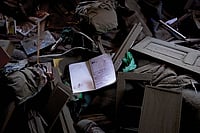INDIA, by all accounts, is a place John Grisham's fictional figures would've been perfectly at home. Access to phone junction boxes is relatively easy, courtesy friendly telephone department linesmen, and a virtually deaf surveillance system is a blessing. No wonder then that Bombay Dyeing chairman Nusli Wadia was blissfully unaware that someone was listening in till the transcripts of his phone conversations on the Tata Tea-ULFA links was frontpaged by The Indian Express. Admits Wadia: "I have no idea now how long this might have been going on. What amazes me is that I have three lines and all three had been tapped."
So how is a phone tapped? Private investigators employ various methods to pry on any telephone indicated by the client—be it the high-flying corporate/political rival or the lowly spouse with suspect inclinations. Sample the popular ones:
The Junction Box Trick: The key to most tapping is that innocuous-looking junction box on every streetcorner.To gain access to it, the private investigator must bribe the linesman—the going rate is Rs 500 a day, but it may vary town to town. Once the linesman cooperates, a wire is clipped on to the line and connected to a switching device which activates the recorder whenever the tapped line crackles to life. The tapping device and the recorder are kept inside the junction box. Equipment of this kind, rough-and-ready and not particularly sophisticated, costs about Rs 4,000 and is often assembled with the help of circuit diagrams. According to private investigators, the equipment is easily available in Karol Bagh and Palika Bazar in Delhi and streetside stalls at Fort, Bombay.
But this trick is not foolproof. Anti-tapping devices—which set off an alarm or jam the phone with an extended beep whenever a parallel connection comes on line—can easily detect foul play. The Gujarat Communications Electronics Limited manufactures this device, which costs Rs 4,000 and are popular in both government and corporate offices. Then again, a phone-tapper can easily bypass the beep or similar warnings by using more high-faluting equipment. These use, instead of parallel connections, the series mode—roughly, the difference here will be that between a three-pin multi-plug and a node-to-node connection.
The Induction Tap: It costs about Rs 70,000 but is believed to be the most reliable and can fool conventional anti-tapping devices. Instead of plugging on to a line inside a junction box, the induction tap is wound around the line without actually touching it. A miniature FM transmitter attached to it picks up the message and beams it to an FM receiver from which it can be recorded. Alternatively, The signal can be diverted to another telephone and then recorded. Since this mini-gizmo can be placed at any point between the junction box and the telephone, even the linesman needn't be disturbed. The coil and the transmitter are no bigger than a sugar cube and can be easily concealed.
The Cellphone Interception: It's a myth that a cellphone can't be tapped. Experts say it's easy to monitor cellphones since it works on a radio transmitter and receiver. By turning in to the correct frequency, calls can be intercepted. Also, a cellphone can be tampered with by using an identical SIM card.
The Telephone Bug: The most conventional mode of tapping, here a microphone is placed inside the receiver which transmits the message to a recorder. Only, this method works on an unsuspecting subject. Most established private detective agencies use bugs since the equipment comes cheap, for less than Rs 10,000. One-track conversations can, of course, be recorded by bugging room with sensitive mikes or miniature video cameras, the size of a two pin plug or even smaller.
Computer Tapping: This is a computer hooked to a modem with which phone lines can be tapped anywhere in the world, simultaneously. It can bypass most anti-tap devices but has a hefty price tag -- $140,000 - and no private investigator can afford it. In India, only the CBI, IB and RAW have this equipment.
The Cost: Contrary to popular belief, most established detective agencies which figure in the Yellow Pages do not take on phone-tapping jobs. At most, these agencies may bug the phone of an errant spouse and charge Rs 3,000 for a two-hour shift. Corporate houses and politicians are usually put under surveillance of private eyes (or ears) who keep a low profile and do not advertise their services. They charge a packet - Rs 10,000 for a 24-hour service. Tapping is expensive and a lot of money is often lost by hooking up the wrong phone.
The Clients: For private investigators, the government - home ministry, intelligence agencies - is the major source of business. Not surprisingly, New Delhi is the centre of the tapping trade. According to one estimate, about 4,000 phones are being tapped at any given time in New Delhi alone. There are about 30 investigators in the city, many hop over to Mumbai when they get clients there. The government apart, corporate house hire detectives to tap phones of business rivals.
Scrambled eggs: Since those who bug telephones use sophisticated equipment, the conventional Rs 4,000-worth anti-tapping device is no longer considered reliable. It works by detecting a drop in the voltage in the telephone line, an indicator that the line is being tapped. According to investigators, the best possible protection available in the market is the scrambler. It costs about Rs 10,000. The scrambler encrypts the conversation and can be received only by a phone which too has a scrambler. Prior to a call, the person at the other end needs to be alerted so that he can switch on his scrambler. Encryptors are also available for cellphones and fix machines.
If anti-bugging devices are becoming increasingly sophisticated, the phone-tappers too have their ear to the ground when it comes to technology. Today, scramblers may seem to be the best bet, because once phone-tappers crack theencryption code, they could plug it at will. Whether it's a public investigation or a private inquiry.


























